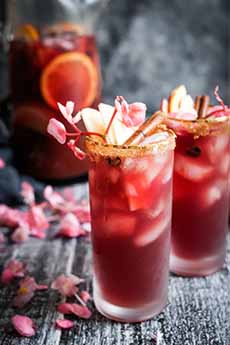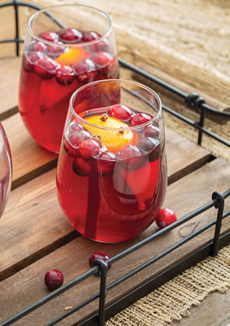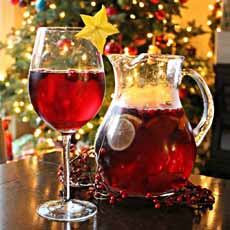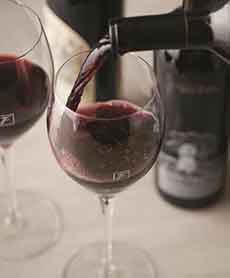Holiday & Winter Sangria Recipe For National Sangria Day
|
It’s ironic that National Sangria Day is celebrated in the gray cold of winter*, when it’s traditionally considered a summer drink. But December 20th is National Sangria Day, and more sangria fans have been enjoying it year-round. As the recipe below shows, you can easily turn sangria into a winter refreshment. Get seasonal with the inclusion of apple cider, cinnamon and oranges, with an optional maple syrup sweetener. Sangria is a wine punch or cocktail† that originated in Spain long ago, with roots in ancient Rome (here’s the history of sangria). There are countless recipes for sangria, made with red, white, or rosé wine, including sparkling wine; and with different spirits, juices and fruits. Here’s a recipe with holiday flavors from Discover California Wines, a trade association for California wine grape growers and vintners. > More sangria recipes. Discover California Wines recommends two California red wines that are especially good with this recipe: In addition to this sangria combines holiday flavors of wine, apple cider, orange slices, and cinnamon sticks. To give it an especially holiday flavor and aroma, use whole cloves to stud the orange slices used for garnish. 1. COMBINE the wine, cider, juice, apple slices, orange slices, and cinnamon sticks in a large pitcher and stir to combine. Taste and add 2-3 tablespoons of maple syrup to sweeten if desired. 2. COVER and refrigerate for at least 30 minutes up to 5 hours, or overnight. When ready to serve… 3. RIM the glasses. Place the brown sugar on a small plate or shallow bowl. Moisten the rim of each glass with an orange wedge and dip it in the brown sugar to coat (twist the glass in the sugar). 4. FILL glasses with ice and fill with sangria. Top with fresh apple and orange slices and a cinnamon stick for garnish. Grenache (French) or Garnacha (Spanish) is a grape varietal not well known in the U.S. If you’ve had a Châteauneuf-du-Pape, you’ve had Grenache. Grenache is the second most widely planted red wine grape variety in the world, according to the Wine Institute. It grows well in hot, dry conditions such as those found in Spain, where the grape most likely originated, in Aragon**. That lets it thrive around the globe, from the Italian isle of Sardinia, the south of France, Australia, California’s Monterey AVA and San Joaquin Valley, and Washington State, among others. In fact, there’s a rumor that there are some 12,000 acres of Grenache vineyards in China [source]. Tablas Creek winery in Paso Robles, California, is largely responsible for the quality of Grenache in California. The worked with the great Château de Beaucastel in Châteauneuf-du-Pape beginning in 1989, to bring in cuttings of superior Côtes du Rhône wine grapes to the U.S. The flavor is generally spicy, berry-flavored (raspberry and strawberry), and soft on the palate. Dig hard and you may find a white pepper spiciness. Depending on where it is grown, you may also find anise, black cherry, cinnamon, and citrus rind, with subtle aromas of orange rind and ruby-red grapefruit. As the wines age, they tend to take on more leather, tobacco, and tar flavors. |
|
|
|
Versatile and medium-bodied, its great range of flavors allows it to pair with a wide range of foods, from grilled shellfish to charcuterie to poultry, beef, lamb and pork. We like it with ham and roast duck. Try it with spicy foods, too. Grenache wines have a relatively high alcohol content, which helps to offset the heat. In addition to red Grenache wines, look for: While the grape may have originated in Spain, the most famous Grenache-based wines in the world come from the Rhône Valley of France, where it is a major component of the wines of Châteauneuf-du-Pape and Côtes du Rhône. Beginning in our college years, we began to try both of those wines, which were prominently featured at the local steakhouse. The reputation of Rhone wines led vintners around the world to make their own grenache-based wines. But you don’t have to reach to Europe to enjoy a bottle of Grenache…or to Spain, or Australia. Check out the wines from California and Washington for starters. And for a fun learning experience, put together a tasting with bottles from all of the main growing areas. Try to compare apples to apples: 100% Grenache varietal, vs. grenache blends (there are more of the latter). While most bottles of Grenache are very affordable, the great ones will cost you. ________________ *To be accurate, December 20th is actually the last day of fall. But it feels like winter! †When spirits are included, sangria becomes a cocktail. Spirits or liquor (they’re the same thing) are fermented, distilled beverages. Liqueur is made from a base of liquor, sweetened and usually flavored. Here are the differences among the different spirits we think of as “liqueur.” ‡Rasteau, Maury, and Banyuls are grenache-based fortified dessert wines from France, where they are called vin doux naturel. The production of vin doux naturel is similar to the production of Port. **From Aragon, it spread throughout the vineyards of Spain and the Mediterranean. By the early 18th century, the varietal had expanded into Languedoc and Provence. Here’s more of the history of grenache.
|
||








